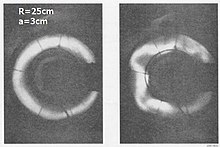Magnetic confinement fusion is an approach to generate thermonuclear fusion power that uses magnetic fields to confine fusion fuel in the form of a plasma. Magnetic confinement is one of two major branches of fusion energy research, along with inertial confinement fusion. The magnetic approach began in the 1940s and absorbed the majority of subsequent development.
Fusion reactions combine light atomic nuclei such as hydrogen to form heavier ones such as helium, producing energy. In order to overcome the electrostatic repulsion between the nuclei, they must have a temperature of tens of millions of degrees, creating a plasma. In addition, the plasma must be contained at a sufficient density for a sufficient time, as specified by the Lawson criterion (triple product).
Magnetic confinement fusion attempts to use the electrical conductivity of the plasma to contain it through interaction with magnetic fields. The magnetic pressureoffsets the plasma pressure. Developing a suitable arrangement of fields that contain the fuel without excessive turbulence or leaking is the primary challenge of this technology.
https://en.wikipedia.org/wiki/Magnetic_confinement_fusion
A kink instability (also kink oscillation or kink mode), is a current-driven plasma instability characterized by transverse displacements of a plasma column's cross-section from its center of mass without any change in the characteristics of the plasma. It typically develops in a thin plasma column carrying a strong axial current which exceeds the Kruskal–Shafranov limit[1][2][3] and is sometimes known as the Kruskal–Shafranov (kink) instability.[4][5]
The kink instability was first widely explored in fusion power machines with Z-pinch configurations in the 1950s.[6] It is one of the common magnetohydrodynamic instability modes which can develop in a pinch plasma and is sometimes referred to as the mode.[6] (The other is the mode known as the sausage instability.)
If a "kink" begins to develop in a column the magnetic forces on the inside of the kink become larger than those on the outside, which leads to growth of the perturbation.[6][7] As it develops at fixed areas in the plasma, kinks belong to the class of "absolute plasma instabilities", as opposed to convective processes.
https://en.wikipedia.org/wiki/Kink_instability
The interchange instability is a type of plasma instability seen in magnetic fusion energy that is driven by the gradients in the magnetic pressure in areas where the confining magnetic field is curved.[1]
The name of the instability refers to the action of the plasma changing position with the magnetic field lines (i.e. an interchange of the lines of force in space[2]) without significant disturbance to the geometry of the external field.[3] The instability causes flute-like structures to appear on the surface of the plasma, and thus the instability is also known as the flute instability.[1][2] The interchange instability is a key issue in the field of fusion energy, where magnetic fields are used to confine a plasma in a volume surrounded by the field.
The basic concept was first noted in a 1954 paper by Martin David Kruskal and Martin Schwarzschild, which demonstrated that a situation similar to the Rayleigh–Taylor instability in classic fluids existed in magnetically confined plasmas. The problem can occur anywhere where the magnetic field is concave with the plasma on the inside of the curve. Edward Teller gave a talk on the issue at a meeting later that year, pointing out that it appeared to be an issue in most of the fusion devices being studied at that time. He used the analogy of rubber bands on the outside of a blob of jelly; there is a natural tendency for the bands to snap together and eject the jelly from the center.
Most machines of that era suffered from other instabilities that were far more powerful, and whether or not the interchange instability was taking place could not be confirmed. This was finally demonstrated beyond doubt by a Soviet magnetic mirror machine during an international meeting in 1961. When the US delegation stated they were not seeing this problem in their mirrors, it was pointed out they were making an error in the use of their instrumentation. When that was considered, it was clear the US experiments were also being affected by the same problem. This led to a series of new mirror designs, as well as modifications to other designs like the stellarator to add negative curvature. These had cusp-shaped fields so that the plasma was contained within convex fields, the so-called "magnetic well" configuration.
In modern designs, the interchange instability is suppressed by the complex shaping of the fields. In the tokamak design there are still areas of "bad curvature", but particles within the plasma spend only a short time in those areas before being circulated to an area of "good curvature". Modern stellarators use similar configurations, differing from tokamaks largely in how that shaping is created.
https://en.wikipedia.org/wiki/Interchange_instability




No comments:
Post a Comment